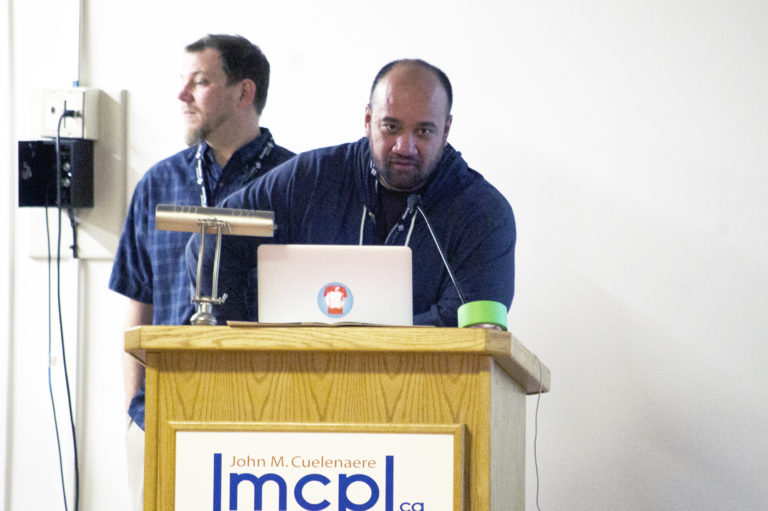
Shane Partridge was the kid who always struggled to fit in.
He was a loner, and was often angry and aggressive. By age 16 he’d been charged with attempted murder. By his mid to late 20s, he was addicted to drugs and in a full-fledged street gang.
“I didn’t have a conscious,” he remembered. “The gang knew I would be violent for drugs.”
You’d never know that just to see and talk with Partridge today. He’s been drug and alcohol free for five years, and on Friday he was sitting patiently in the John M. Cuelenaere Public Library watching experts and community leaders discuss solutions to Prince Albert’s gang problem.
He’s completely escaped the gang lifestyle. Today you’re much more likely to see him sitting on a non-profit board or going door-to-door as a political campaign volunteer than doing drugs or violently attacking a rival.
So what’s the key to getting P.A. gang members to follow the same path he did? For Partridge, it starts with patience.
“It took us (gang members) a lifetime to get to where we’re at,” he said. “(Change) is not going to happen overnight. To some, it lasts a lifetime, where they need some level of support.”
Like most former gang members, Partridge wanted to give back to the community once he got healthy. He helped spur the creation of a provincial gang strategy in Saskatchewan, which was unveiled in Prince Albert on Friday.
The report contains ideas from 90 different organizations and agencies who met for a conference in Saskatoon last May, as well as feedback from groups in more than 20 Saskatchewan communities, including Prince Albert. It contains 24 recommendations in five different categories and asks a fundamental question: how and when does a group of friends turn into a gang?
“It seems (like it’s) just too much when you say we’ve got gang problems,” Partridge says. “But, when you start looking into it and you start saying, ‘well, we have gang problems but here’s where we’re at,’ and then you look at sort of the symptoms—for example, cliques and wannabe’s—and you start brainstorming some of the things you can do to interrupt that and stop that from moving forward into full out street gangs, it makes things more attainable…. Communities actually feel like they can take control of the situation and change things.”
The report’s biggest achievement is the creation of a street gang typology, which classifies potential or current gang members into one of four categories. At the lowest level is a pro-social group of friends that bond through common experiences or goals and find their identity and belonging through the group. The second level includes “Bully Groups and Tagging Crews,” which means the group begins to use violence and intimidation as a means to control outsiders, and start to develop more structure and hierarchy.
The third level is “Cliques and Wannabes,” where groups begin constructing names for themselves and individuals start withdrawing from their families. The fourth level is “Street Gangs and Hate Groups.” At this point, a community has a full-fledged gang problem.
Stan Tuinukuafe, the president of STR8 UP, an organization in Saskatoon that helps gang members leave their old life, said ideally, the report will give communities a starting point that helps them tailor specific programs to specific groups of young adults.
“Some communities will say, ‘hey we recognize we have gangs as a problem. We really need extra supports on the type of resources like addictions, trauma and parenting programs,’” Tuinukuafe explained.
“Other communities, they don’t really know where they’re at, so they want to develop the leadership to say, who are the key stakeholders in our community to address this, so every community is different with where they’re at.”
STR8 UP has played a role in helping countless gang members leave their old lives, including Shane Partridge. However, Tuinukuafe stresses that STR8 UP is a program developed specifically for Saskatoon. Prince Albert may have similar problems, he said, but how the city addresses those problem could like quite different.
“Usually what happens is our government comes and generally says, here’s a program that we think would fit for your community. Make it work,” he said.
“Where as what we’re saying is communities need to identify what works for them, and develop the metrics behind it. That’s what we’re hoping for.”
Prevention is just part of the problem, however. Both Tuinukuafe and Partridge stress the need for more resources to help gang members exiting prison get the help they need. Prince Albert is a pivotal area in that regard, especially since not all gang members leave their old life behind on the first try.
Partridge admits that he himself relapsed and fell off the grid for two years before returning to STR8 UP a second time. It was forgiveness, patience and long-term commitment from the organization that helped him break free. He might not have been in Prince Albert on Friday if none of those three things had happened.
“They didn’t hold any judgments,” Partridge remembered. “I didn’t go around for a long time when I relapsed because I felt like I had failed them in a sense, but as soon as I went back to the office, they were basically saying, ‘hurry up! Come back in!’”
There will be further reaction to the provincial gang strategy report in Tuesday’s edition of the Daily Herald.
